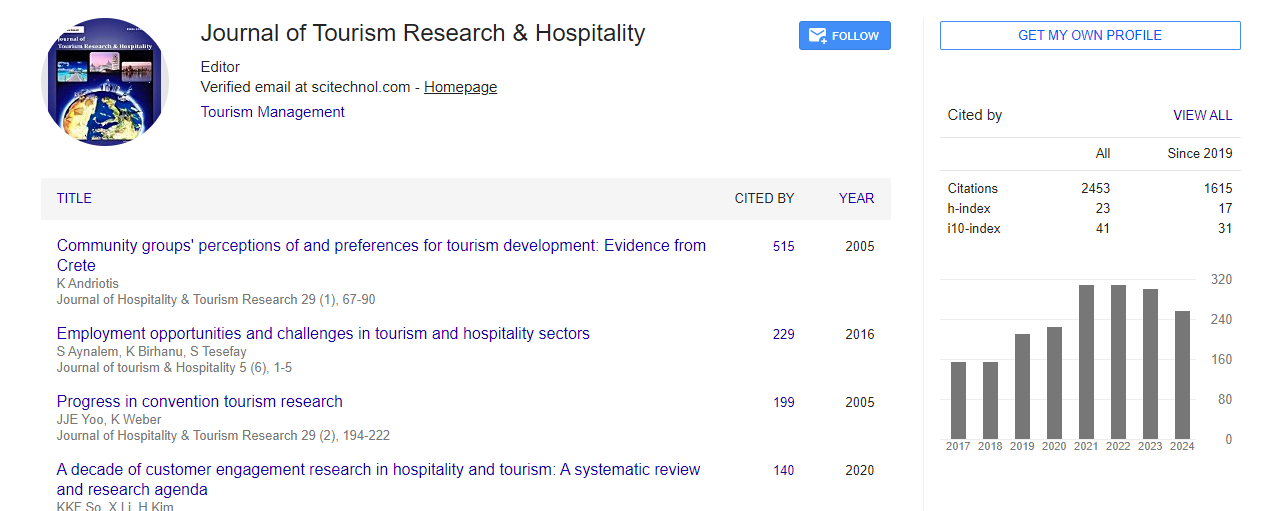Commentary, J Tourism Res Hospitality Vol: 10 Issue: 6
Need for sustainable tourism development and sustainable tourism in environmental dimension
Andrew Walls*
Andrew Walls
*Corresponding Author:
Andrew Walls
Department of Hospitality and Tourism Management, San Francisco State University, USA
E-mail: Kaufman@ucf.edu
Received Date: June 22, 2021; Accepted Date: June 29, 2021; Published Date: July 06, 2021
Citation: Walls A (2021) Need for Sustainable Tourism Development and Sustainable Tourism in Environmental Dimension. J Tourism Res Hospitality 10:6. e112.
InTourism is one among the world’s fastest growing industries and a crucial source of exchange and employment, while being closely linked to the social, economic, and environmental well-being of the many countries, especially developing countries.
Sustainable tourism is that the tourism that takes full account of its current and future economic, social and environmental impacts, addressing the requirements of tourists, the industry, the environment and host communities. Tourism can involve primary transportation to the overall location, local transportation, accommodations,
entertainment, recreation, nourishment and shopping. It is often associated with travel for leisure, business and visiting friends and relatives. There’s now broad consensus that tourism development should be sustainable.
Basically, once we mention sustainable development, the simplest definition is what we, this generation, have inherited a particular amount of ecology and environment surrounding in terms of land, water, and air; once we leave it to subsequent generation, we should always leave it a minimum of within the same condition, of not during a better condition than what we inherited. This is often the sum and substance if sustainable development, putting it in elementary terms.”
Need for sustainable tourism development Until the start of last decade tourism was seen as a profitable sector of business with no obvious constraints to growth, few barriers to entry to the market, an almost, universal welcome from governments and, for the foremost part, entailing few effective regulatory requirements to require the environment under consideration. Commercial organizations, large and little, act on the Dawkin’s principle of self-interest. They are doing not make significant changes to the way they are doing business, which might be due to exhortations or out of excellent intentions, except in response to the pressure of external factors that can’t be avoided or to seize a competitive advantage.
International tourism has brought during a introduce which the opportunities of creating quick profits from exploiting what was considered freely available natural resources dazzled the eyes of state and businessmen, also as many local residents. Environmental dimension To many people, sustainability is about the environment, primarily the natural, physical environment, and its protection. However, there’s much more to the environment than simply the natural landscape. Five aspects of the environment The natural resources: Tourism makes use of a variety of natural resources, and in many cases, the core attraction of a destination’s product could also be natural resources like clean air, land, mineral waters, and therefore the water in lakes and seas. The natural environment: There are few natural landscape or wilderness areas left within the world. most natural landscapes are affected to some extent by the actions of man through the centuries. Tourism is merely one industry or activity which changes landscapes. The natural landscape represents the core of the tourism product in many areas including natural forests, mountains, and regions which magnetize tourists due to their rivers and lakes.
The farmed environment: The farmed environment can cover a various range of agricultural systems including agriculture landscapes, man-made forests, and fish farms. Wildlife: Wildlife features a number of dimensions like land-based mammals and reptiles, flora, birds, insects, fish, and marine mammals. Tourism can clearly be very harmful to wildlife through the destruction of habitats, affecting feeding habits, disrupting breeding patterns, fires in woodlands and other people picking rare plants. The build environment: We also got to recognize that, in term of tourism, there are several dimensions to the built environment like individual buildings and structures, villages and townscapes, transport infrastructure, dams, and reservoirs.
 Spanish
Spanish  Chinese
Chinese  Russian
Russian  German
German  French
French  Japanese
Japanese  Portuguese
Portuguese  Hindi
Hindi 

